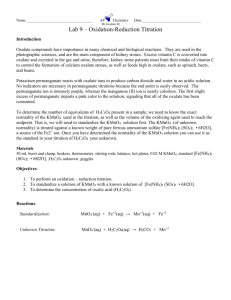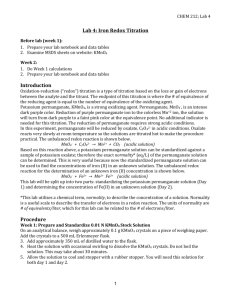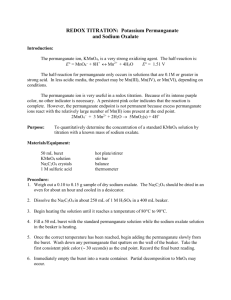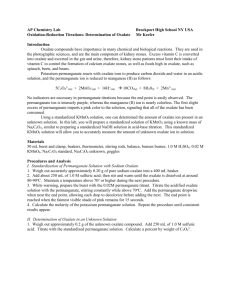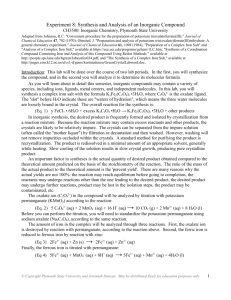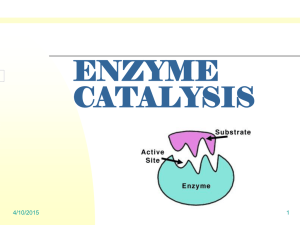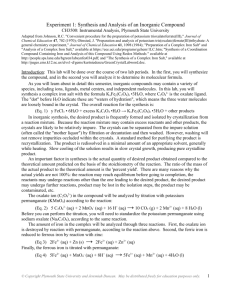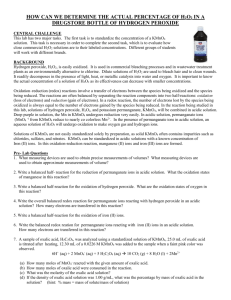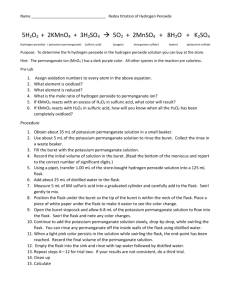Experiment 8 – Redox Titrations Potassium permanganate, KMnO4
advertisement
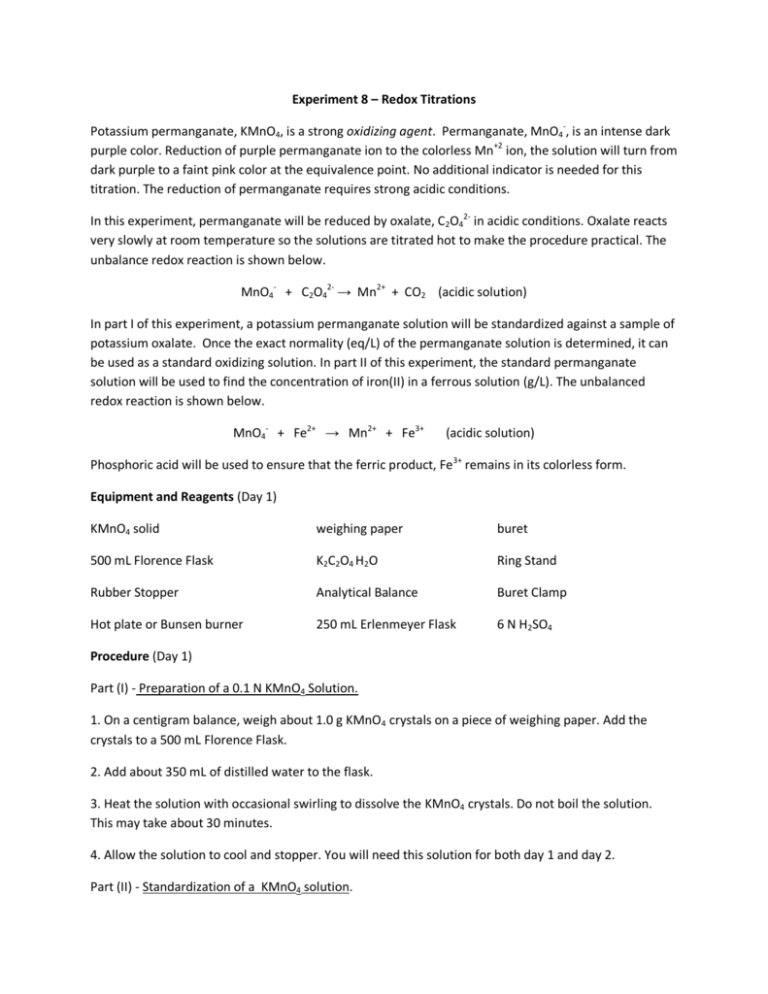
Experiment 8 – Redox Titrations Potassium permanganate, KMnO4, is a strong oxidizing agent. Permanganate, MnO4-, is an intense dark purple color. Reduction of purple permanganate ion to the colorless Mn+2 ion, the solution will turn from dark purple to a faint pink color at the equivalence point. No additional indicator is needed for this titration. The reduction of permanganate requires strong acidic conditions. In this experiment, permanganate will be reduced by oxalate, C2O42- in acidic conditions. Oxalate reacts very slowly at room temperature so the solutions are titrated hot to make the procedure practical. The unbalance redox reaction is shown below. MnO4- + C2O42- → Mn2+ + CO2 (acidic solution) In part I of this experiment, a potassium permanganate solution will be standardized against a sample of potassium oxalate. Once the exact normality (eq/L) of the permanganate solution is determined, it can be used as a standard oxidizing solution. In part II of this experiment, the standard permanganate solution will be used to find the concentration of iron(II) in a ferrous solution (g/L). The unbalanced redox reaction is shown below. MnO4- + Fe2+ → Mn2+ + Fe3+ (acidic solution) Phosphoric acid will be used to ensure that the ferric product, Fe3+ remains in its colorless form. Equipment and Reagents (Day 1) KMnO4 solid weighing paper buret 500 mL Florence Flask K2C2O4 H2O Ring Stand Rubber Stopper Analytical Balance Buret Clamp Hot plate or Bunsen burner 250 mL Erlenmeyer Flask 6 N H2SO4 Procedure (Day 1) Part (I) - Preparation of a 0.1 N KMnO4 Solution. 1. On a centigram balance, weigh about 1.0 g KMnO4 crystals on a piece of weighing paper. Add the crystals to a 500 mL Florence Flask. 2. Add about 350 mL of distilled water to the flask. 3. Heat the solution with occasional swirling to dissolve the KMnO4 crystals. Do not boil the solution. This may take about 30 minutes. 4. Allow the solution to cool and stopper. You will need this solution for both day 1 and day 2. Part (II) - Standardization of a KMnO4 solution. 1. On weighing paper, weigh about 0.2 – 0.3 g of K2C2O2H2O on the analytical balance. Record the exact mass. Transfer the sample to a 250 mL Erlenmeyer flask. 2. Rinse and fill the buret with the KMnO4 solution. 3. Add 50 mL of distilled water and 20 mL of 6 N H 2SO4 to the oxalate sample in the Erlenmeyer flask. Swirl to dissolve the solids. 4. Heat the acidified oxalate solution to about 85 °C. Do not boil the solution. 5. Record the initial buret reading. Because the KMnO4 solution is strongly colored, the top of the meniscus may be read instead of the bottom. 6. Titrate the hot oxalate solution with the KMnO4 solution until the appearance of a faint pink color. 7. Record the final buret reading and calculate the volume of KMnO4 used in the titration. 8. Discard the titration mixture down the drain and repeat the titration with a new sample of oxalate for a total of 2 trials. 9. An oxalic acid solution may be used to wash the buret and the titration flask if a brown stain remains in the glassware. Calculations 1. Using the half-reaction method, write a balanced redox equation for the reaction of permanganate with oxalate in an acidic solution. 2. Calculate the equivalent weight of the oxalate reducing agent from the molar mass of the oxalate sample and the equivalence of electrons lost by the reducing agent in the oxidation half-reaction. 𝑒𝑞𝑢𝑖𝑣𝑎𝑙𝑒𝑛𝑡 𝑤𝑒𝑖𝑔𝑡 = 184 𝑔/𝑚𝑜𝑙 # 𝑜𝑓 𝑒𝑙𝑒𝑐𝑡𝑟𝑜𝑛𝑠 𝑒𝑞/𝑚𝑜𝑙 3. Use the sample mass and the equivalent weight to calculate the number of equivalents of oxalate in each sample. 𝑒𝑞𝑢𝑖𝑣𝑎𝑙𝑒𝑛𝑐𝑒 𝑜𝑓 𝑟𝑒𝑑𝑢𝑐𝑖𝑛𝑔 𝑎𝑔𝑒𝑛𝑡 = 𝑠𝑎𝑚𝑝𝑙𝑒 𝑚𝑎𝑠𝑠 𝑔 × 𝑒𝑞 __ 𝑔 At the equivalence point, the equivalence of the reducing agent is equal to the equivalence of the oxidizing agent. eqred = eqox 4. Calculate the normality of the KMnO4 solution from the equivalence of the oxidizing agent and the volume used in the titration. 5. Calculate the average normality of the permanganate solution. Equipment and Reagents (Day 2) Unknown Fe2+ solution KMnO4 solution Buret Clamp 250 mL Erlenmeyer Flask 25 mL pipet Ring Stand 6 N H3PO4 pipet bulb Procedure (Day 2) Part (III) – Determination of the Mass of Iron in a Ferrous Solution. 1. Pipet a 25 mL sample of the unknown Fe2+ solution into a 250 mL Erlenmeyer flask. 2. Add 50 mL of distilled water and 12 mL of 6 N H 3PO4 into the flask. 3. Fill a buret with the standard KMnO4 solution and record the initial buret reading. 4. Titrate the sample with the standard KMnO4 to a faint pink end-point and record the final buret reading. Calculate the volume of KMnO4 used. 5. Discard the ferric solution down the drain and repeat the titration with a new sample of the ferric solution for a total of 2 trials. 6. When finished with all trials, discard the purple permanganate solution in the appropriate waste container in the fume hood. 7. Oxalic acid may be used to remove any brown stains left on the glassware. Calculations 1. Using the half-reaction method, balance the redox reaction of permanganate with iron(II) in acidic media. 2. Calculate the equivalence of KMnO4 titrated. 𝑒𝑞 𝐸𝑞𝑢𝑖𝑣𝑎𝑙𝑒𝑛𝑐𝑒 𝑜𝑓 𝑜𝑥𝑖𝑑𝑖𝑧𝑖𝑛𝑔 𝑎𝑔𝑒𝑛𝑡 = 𝑁𝑜𝑥 × 𝑉𝑜𝑥 = ( ) × 𝐿 𝐿 At the equivalence point, the equivalence of the oxidizing agent is equal to the equivalence of the reducing agent. eqox =eqred Determine the normality of the ferric reducing agent. 𝑁𝑟𝑒𝑑 = 𝑒𝑞𝑟𝑒𝑑 0.025 𝐿 3. Calculate the molarity (mol/L) of the ferrous solution. 𝑀𝐹𝑒 = 𝑁𝐹𝑒 𝑛 (n = moles of electrons lost in the oxidation half-reaction.) 4. Calculate the mass concentration (g/L) of iron in the unknown solution by multiplying the molar mass of iron by the molarity of the ferrous solution. 𝑚𝑎𝑠𝑠 𝑐𝑜𝑛𝑐𝑒𝑛𝑡𝑟𝑎𝑡𝑖𝑜𝑛 = 𝑚𝑜𝑙 56𝑔 𝑔 × = 𝐿 𝑚𝑜𝑙 𝐿 5. Calculate the average mass concentrations for the ferrous unknown solution.
